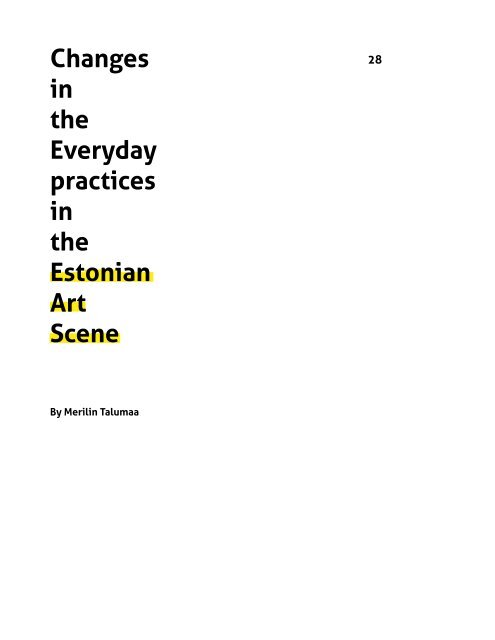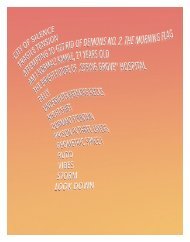X YPP Book
The main aim of the project - to discover new talent in Baltic States.
The main aim of the project - to discover new talent in Baltic States.
You also want an ePaper? Increase the reach of your titles
YUMPU automatically turns print PDFs into web optimized ePapers that Google loves.
Changes<br />
in<br />
the<br />
Everyday<br />
practices<br />
in<br />
the<br />
Estonian<br />
Art<br />
Scene<br />
By Merilin Talumaa<br />
28<br />
OVERVIEW OF THE INSTITUTIONAL PATTERNS<br />
An overview of the young generation of Estonian artists would be impossible<br />
without a reflection on how the local art scene benefited from the general changes<br />
at the institutional level. There have been significant changes during the past<br />
six years (although their origins go back further in time)—a period during which<br />
a new generation of artists, curators, critics, directors and project managers have<br />
emerged. In contrast to the previous times, their roles are often intertwined and<br />
their everyday work is directed outwards, toward achieving international cooperation<br />
and acknowledgement.<br />
The Estonian Contemporary Art Development Center (ECADC), a noteworthy newcomer<br />
in the local art scene, started its work in 2012 under the direction of Karin<br />
Laansoo. Although at first the aims of ECADC seemed similar to those of the Center<br />
for Contemporary Arts Estonia (CCAE, since 2013 directed by Maria Arusoo,<br />
the commissioner of the Estonian Pavilion at the Venice Biennale since 1999, and<br />
a co-commissioner of the Baltic Triennial since 2016), ECADC proved itself to be<br />
active on an even bigger scale. The ECADC has initiated a significant part of large<br />
scale international projects, including Outset Estonia, Estonian Pavillion Without<br />
Walls at the Performa Biennial 2017, the Curatorial Program for Research, and<br />
Gallerist Master Course. This activity has played a big part in the careers of many<br />
Estonian artists mainly still in their late 20s, 30s and early 40s, as they were introduced<br />
to the international audiences.





